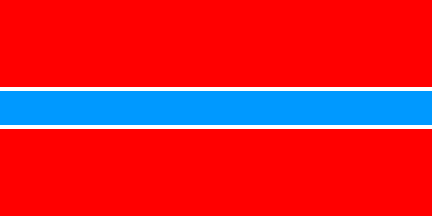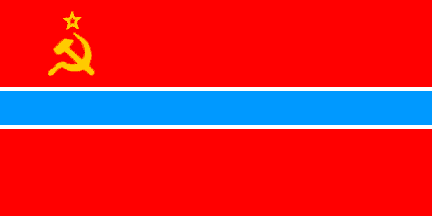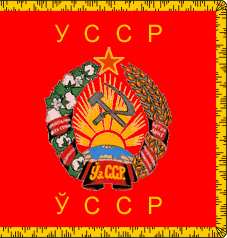
image by António Martins, 28 Oct 2002 |

Last modified: 2025-01-11 by rob raeside
Keywords: uzbekian ssr | uzbekistan | hammer and sickle (yellow) | hammer and sickle (grey) | star: 5 points (fimbriated) | sun: rising | cotton | u3.c.c.p. | ŭz.s.s.r. | ўз.С.С.Р. |
Links: FOTW homepage |
search |
disclaimer and copyright |
write us |
mirrors

Red with blue bar, fimbriated white, with the following measures
(respective to the height of the flag, from top to bottom):
2/5ths of red, 1/50th of white, 8/50ths of green, 1/50th of white
and 2/5ths of red. See here also
detailed construction information of the hammer and sickle.
Mark Sensen, 25 May 1997
Stripes: 20+1+8+1+20. Star is contained in imaginary circle of
diameter one-tenth of flag height. hammer and sickle in imaginary square of sides
one-fifth of flag height. Imaginary circle of star touches the imaginary
square of hammer and sickle. Centre of star is at point one-tenth of flag height
from upper edge of flag. Vertical ax of star and hammer and sickle at one-third of
flag height (= one-sixth of flag length).
Mark Sensen, 20 Jun 2001, quoting
[sol85]
According to Sokolov’s book [sol85],
the thin white stripes are not just due to a heraldic concern, as «The
light-blue stripe symbolises the cloudless sky over Uzbekistan sending
generous rays of the sun to the fertile soil. White edgings at the
light-blue stripe represent advanced cotton growing — “the white gold”
of the Republic.».
Mark Sensen, 20 Jun 2001
The last change of the soviet era was made on 29 August 1952 (Decree
of the Presidium of the Supreme Soviet), when the striped flag was adopted.
The blue is for the sky and the white is for the cotton; the red is the
revolutionary struggle of the working masses; the hammer and sickle is the
union of the workers and peasantry, and the star is symbol of the proletariat
international. The flags have several regulations and dispositions about
this: 1 November 1952, 30 December 1953, 31 October 1955, 27 September 1974,
14 October 1974 and 30 July 1981.
Jaume Ollé, 08 Oct 1996
 image by António Martins, 28 Oct 2002 | |
No hammer, sickle and star on the
reverse side.
Mark Sensen, 25 May 1997
Officially reverse looked like obverse without star and hammer-sickle.
But in fact I never saw these flags without star, hammer-sickle. Real flags
(all 15) usually were either with reverse analogous
to obverse (but with star and hammer-and-sickle near the hoist) or with
reverse = mirrored obverse.
Victor Lomantsov, 30 Nov 2002

Many (all?) soviet republics had these
banners. Usually it was red field with republican
coat-of-arms and the name of republic.
They had gold fringe. I know about such banner of Uzbekistan.
Victor Lomantsov, 09 Jan 2002
uz.gif)
The emblem of the SSR was introduced on 14 February 1937 by
art. 143 of the then constitution (according to Hesmer
[hes92]) and it was replaced by
the current one July 1992.
The current emblem retains many parts of the old SSR one: the
grain and cotton wreaths, the ribbon (in the national colours
now, though) with inscription, the sun, and even the star: this
is, however, an eight-pointed blue star now instead of the
communist five-pointed red star.
M. Schmöger, 16 Sep 2001
Anything below this line was not added by the editor of this page.